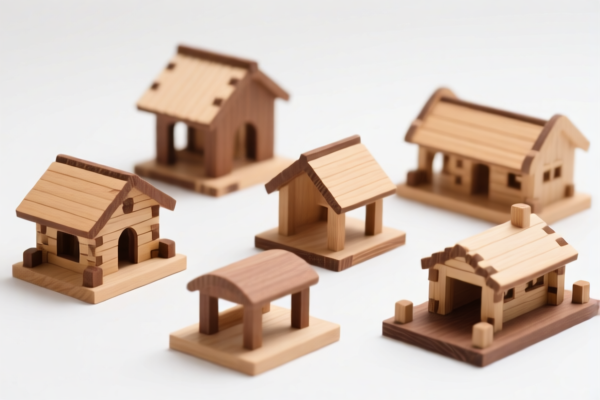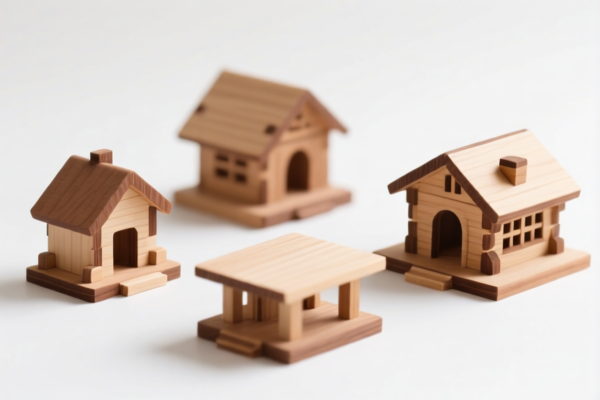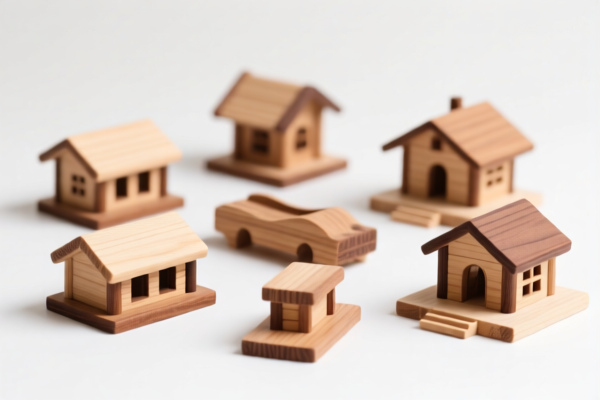| HS Code | Official Doc | Tariff Rate | Origin | Destination | Effective Date |
|---|---|---|---|---|---|
| 9503000090 | Doc | 30.0% | CN | US | 2025-05-12 |
| 9503000071 | Doc | 30.0% | CN | US | 2025-05-12 |
| 4420190000 | Doc | 33.2% | CN | US | 2025-05-12 |
| 4420908000 | Doc | 58.2% | CN | US | 2025-05-12 |
| 4421919300 | Doc | 55.0% | CN | US | 2025-05-12 |
| 4421999300 | Doc | 55.0% | CN | US | 2025-05-12 |




Wooden Model
A wooden model is a three-dimensional representation constructed primarily from wood, typically created as a miniature version of an existing object or a conceptual design. These models serve diverse purposes, ranging from artistic expression to functional prototyping and educational tools.
Material
The primary material is wood, though the specific type varies widely. Common choices include:
- Balsa wood: Lightweight and easy to cut, favored for aircraft models and delicate structures.
- Basswood: Fine-grained, stable, and takes detail well; often used for carving and architectural models.
- Pine: Affordable and readily available, suitable for larger, simpler models.
- Hardwoods (e.g., maple, oak, walnut): Durable and aesthetically pleasing, used for high-quality display models and furniture prototypes.
- Plywood: Offers strength and stability for larger structures.
Adhesives (wood glue, cyanoacrylate), finishes (paint, varnish, stain), and occasionally other materials like metal fasteners or plastic components are also used.
Purpose
- Hobby & Collectibles: Model kits of vehicles (cars, ships, airplanes), buildings, and figures are popular pastimes. Completed models are often collected as display items.
- Architecture: Architects use wooden models to visualize designs, present concepts to clients, and study spatial relationships.
- Engineering & Prototyping: Engineers create wooden models to test designs, evaluate functionality, and refine concepts before investing in more expensive materials.
- Educational Tools: Wooden models are used in schools and universities to teach concepts in geometry, physics, engineering, and design.
- Art & Sculpture: Artists employ wood modeling techniques to create three-dimensional artwork.
- Furniture Design: Scale models are used to visualize and refine furniture designs before full-scale production.
Function
The function of a wooden model depends heavily on its purpose. It can be purely aesthetic, serving as a decorative object. Alternatively, it can be functional, providing a tangible representation of a design for testing or presentation. Some models are designed to be assembled, disassembled, or even animated.
Usage Scenarios
- Home/Studio: Assembly of model kits, display of completed models, artistic creation.
- Architectural Firms: Design visualization, client presentations, internal design reviews.
- Engineering Labs: Prototyping, testing, and refinement of mechanical designs.
- Classrooms: Hands-on learning of geometric principles and design concepts.
- Museums/Galleries: Display of historical models or artistic sculptures.
Common Types
- Static Models: Represent finished objects and are typically glued together for permanent display (e.g., ship models, car models).
- Kit Models: Sold as unassembled parts requiring assembly using glue, paint, and tools.
- Architectural Models: Detailed representations of buildings or urban landscapes. Can range from simple massing models to highly detailed renderings.
- Functional Models: Designed to demonstrate how something works (e.g., a working steam engine model).
- Scale Models: Represent objects at a reduced size, maintaining accurate proportions.
- Block Models: Simple representations using geometric blocks, often used in early design stages.
- Laser-Cut Models: Precisely cut wooden pieces assembled to create intricate designs.
- Carved Models: Created by hand or machine carving from solid wood blocks.
Wooden models can fall under several classifications depending on their specific characteristics and intended use. Here's a breakdown of potential HS codes based on the provided information:
- 4420.19.00.00: This code covers wood marquetry and inlaid wood; caskets and cases for jewelry or cutlery and similar articles, of wood; statuettes and other ornaments, of wood; wooden articles of furniture not falling within chapter 94. Specifically, it refers to statuettes and other ornaments of wood. This would apply if the wooden model is primarily decorative.
- 44: Chapter 4 – Wood and articles of wood; wood charcoal.
- 20: Heading 20 – Wood marquetry and inlaid wood; caskets and cases for jewelry or cutlery and similar articles, of wood; statuettes and other ornaments, of wood; wooden articles of furniture not falling within chapter 94.
- 19: Subheading 19 – Statuettes and other ornaments.
- 4420.90.80.00: This code also falls under wood marquetry and inlaid wood; caskets and cases for jewelry or cutlery and similar articles, of wood; statuettes and other ornaments, of wood; wooden articles of furniture not falling within chapter 94, but covers "Other" wooden articles not specifically categorized elsewhere within the chapter. This could apply if the model doesn't fit the definition of a statuette or ornament.
- 44: Chapter 4 – Wood and articles of wood; wood charcoal.
- 20: Heading 20 – Wood marquetry and inlaid wood; caskets and cases for jewelry or cutlery and similar articles, of wood; statuettes and other ornaments, of wood; wooden articles of furniture not falling within chapter 94.
- 90: Subheading 90 – Other.
- 80: Further specification – Other.
- 4421.91.93.00: This code covers other articles of wood, specifically those of bamboo, and further specifies theatrical, ballet, and operatic scenery and properties, including sets. If the wooden model is intended for use as a prop or scenery, this code may be applicable.
- 44: Chapter 4 – Wood and articles of wood; wood charcoal.
- 21: Heading 21 – Other articles of wood.
- 91: Subheading 91 – Other.
- 93: Further specification – Of bamboo.
- 4421.99.93.00: Similar to the above, this code covers other articles of wood, but without the bamboo specification, and also specifies theatrical, ballet, and operatic scenery and properties, including sets. This could apply if the model is a prop and not made of bamboo.
- 44: Chapter 4 – Wood and articles of wood; wood charcoal.
- 21: Heading 21 – Other articles of wood.
- 99: Subheading 99 – Other.
- 93: Further specification – Other.
Regarding HS code 4420.19.00.00 and 4420.90.80.00, please note the need to verify the specific characteristics of the wooden model to determine if it qualifies as a statuette or ornament, or falls under the "Other" category.
Customer Reviews
No reviews yet.